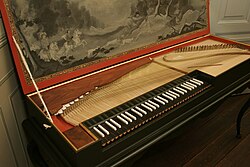Tangent (clavichord)

1977 unfretted clavichord by Keith Hill, Op. 44 (Op. 28 reworked)
|
|
| Keyboard instrument | |
|---|---|
| Hornbostel–Sachs classification | 314.122-4-8 (Simple chordophone with keyboard sounded by tangents) |
| Developed | Early 14th century |
The clavichord is a European stringed keyboard instrument that was used largely in the late Medieval, through the Renaissance, Baroque and Classical eras. Historically, it was mostly used as a practice instrument and as an aid to composition, not being loud enough for larger performances. The clavichord produces sound by striking brass or iron strings with small metal blades called tangents. Vibrations are transmitted through the bridge(s) to the soundboard.
The name is derived from the Latin word clavis, meaning "key" (associated with more common clavus, meaning "nail, rod, etc.") and chorda (from Greek χορδή) meaning "string, especially of a musical instrument". An analogous name is used in other European languages (It. clavicordio, clavicordo; Fr. clavicorde; Germ. Klavichord; Lat. clavicordium; Port. clavicórdio; Sp. clavicordio). Many languages also have another name derived from Latin manus, meaning "hand" (It. manicordo; Fr. manicorde, manicordion; Sp. manicordio, manucordio). Other names refer to the monochord-like nature of a fully fretted clavichord (It. monacordo or monocordo; Sp. monacordio). Italian also used sordino, a reference to its quiet sound (sordino usually designates a mute).
The clavichord was invented in the early fourteenth century. In 1504, the German poem "Der Minne Regeln" mentions the terms clavicimbalum (a term used mainly for the harpsichord) and clavichordium, designating them as the best instruments to accompany melodies.
One of the earliest references to the clavichord in England occurs in the privy-purse expenses of Elizabeth of York, queen of Henry VII, in an entry dated August 1502:
Item. The same day, Hugh Denys for money by him delivered to a stranger that gave the queen a payre of clavycordes. In crowns form his reward iiii libres.
The clavichord was very popular from the 16th century to the 18th century, but mainly flourished in German-speaking lands, Scandinavia, and the Iberian Peninsula in the latter part of this period. It had fallen out of use by 1850. In the late 1890s, Arnold Dolmetsch revived clavichord construction and Violet Gordon-Woodhouse, among others, helped to popularize the instrument. Although most of the instruments built before the 1730s were small (four octaves, four feet long), the latest instruments were built up to seven feet long with a six octave range.
...
Wikipedia
